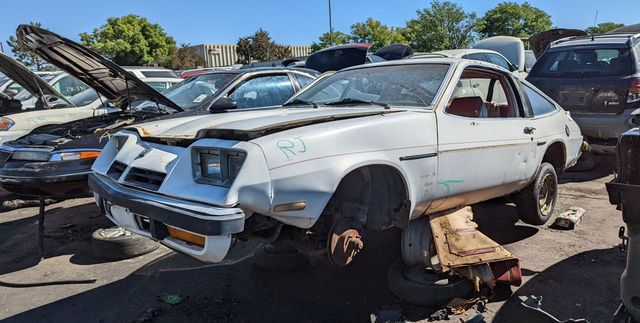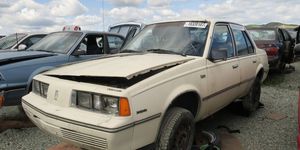General Motors developed the Chevrolet Vega as a modern, efficient subcompact, and it hit American streets for the 1971 model year. More than two million were sold, but the Vega was plagued by heavily publicized reliability and corrosion problems. Sales plunged after 1974. Its successor, the Chevrolet Monza, was based on the Vega chassis but looked much sleeker and had a sportier air about it. Buick, Pontiac, and Oldsmobile got their own versions of the Monza, and the Olds version is by far the hardest to find today. Here's a patriotic 1976 Oldsmobile Starfire in a self-service yard just outside of Denver.
This one had its badges pried off when I found it, but the shadow of a Seventy-Six emblem can be made out just above the shadow of the Starfire badge. 1976 was the year of the Bicentennial of the founding of the United States, and many car companies (even Volkswagen) offered special Bicentennial editions during the 1974-1976 period. As far as I can tell, Oldsmobile never sold Bicentennial-themed Starfires, so I think this badge was part of a dealer-created option package.
The pop-up sunroof may have been part of that dealer package, though it looks more like an aftermarket unit from the 1980s.
All 1975-1980 Starfires (not to be confused with the 1950s and 1960s Starfires) were hatchbacks, based on the Monza 2+2, and the 231-cubic-inch (3.8-liter) Buick V6 was the only Starfire engine available for 1975 and 1976. Later on, Vega 140 and Iron Duke four-cylinders became base Starfire plants, and an optional Chevy 305 (5.0-liter) small-block could be had in 1977 through 1979. This V6 was rated at 110 horsepower.
A four-speed manual transmission was standard equipment in the 1976 Starfire, and that's what this car has. For an extra $244 (about $1300 in 2022 dollars), you could get a five-speed manual or a three-speed automatic.
The build tag says this car came from the now-demolished South Gate Assembly plant in Los Angeles, which was also the place where my 1965 Impala sedan was born. The MSRP was $3882, or about $20,685 today. I had a friend in high school with a 1976 Buick Skyhawk, essentially the same car, and it was respectably quick by early-1980s standards.
My friend's Skyhawk had plenty of build-quality problems at age seven years, including a driver's-side door latch striker that broke off and required a difficult welding repair to fix. This car must have had the same problem at some point.
1975-1980 Starfires are nearly extinct now, and very nice ones can sell for decent enough money. This one doesn't have much rust, but it still would cost $15,000 to make it a $10,000 car.
Starfire, born of steel! The new Starfire from Oldsmobile!
The Skyhawk got a song that managed to be even schmaltzier.
The Pontiac Sunbird version was available as a notchback coupe, and (if we are to believe this commercial) must have had 900 horsepower.
The Monza 2+2 was the future.

























